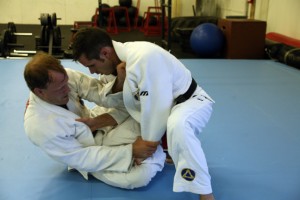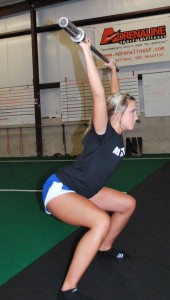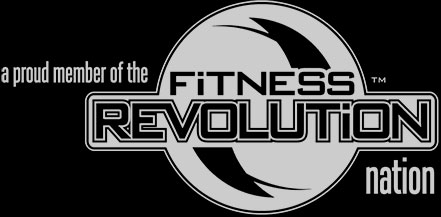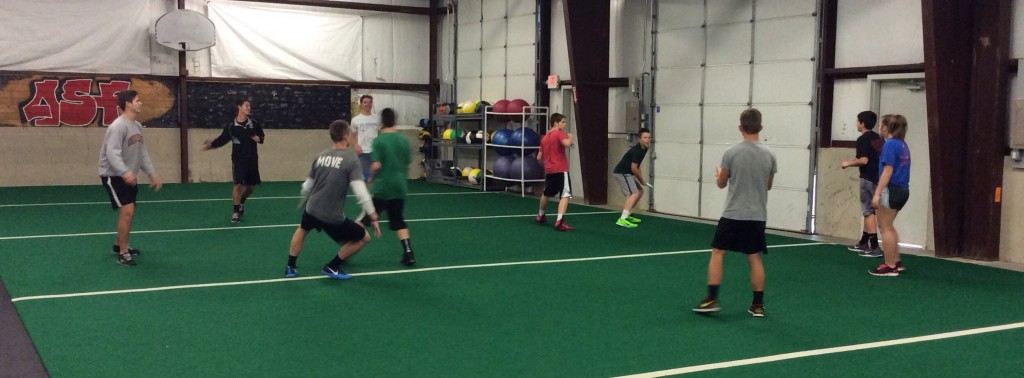originally written on September 21, 2010.
I was recently watching a group of kids struggling the other day and was trying to figure out why. Was the drill too tough? Were they too tired? Did I not coach it correctly? As I left that night, I came to the conclusion that there could have been any number of reasons, but the fact that they were all physically not as strong as they should be stuck out more than anything else.
In looking at our program design layout, you will notice that we always perform strength and power training after our movement skills. Effective and efficient movement of the body is priority number one. However, I am convinced that movement patterns, especially speed, will only be reinforced and improved through gaining strength. So, I am going to modify our training protocols to include more strength than we have before.
Here are some thoughts as to why strength training is so good for young kids:
1) Before the onset of puberty and during puberty, the Central Nervous System can be thought of as mold-able, or plastic. It is still capable of being introduced to a stimulus, adapting and starting the process of changing relatively quickly. Older athletes and adults are capable of this also but not at the level of young children. These tools will form the foundation for which further changes can occur.
2) We can move a kid as we strengthen them. Typically, strength training is limited to the space of the equipment in use, but in our world of bands, sleds, climbing, crawling, etc, the movement patterns and the strength patterns happen simultaneously. An example would be a walking sled press instead of a bench press, or a sled march instead of a squat. That doesn’t mean we will not use those exercises, but there are options beside the traditional means.
3) While it is a cliche, balance of the body is important for performance and injury prevention. Generally, balance will involve front/back, side/side and top/bottom; it will not always mean an equal ratio, however. For instance, our baseball players will always perform 2 to 3 posterior upper body movements for every anterior movement. Runners may perform more hip extension than hip flexion. Jiu Jitsu players and wrestlers may do core work on their backs more often than a football player. Once the body is looked at Generally, it can be broken down Specifically and Competitively based on the demands and needs of the sport.

4) Strength, more than any other motor skill, seems to have the greatest transfer to improvements in all other motor skills. As strength improves, acceleration, deceleration, jump height, jump distance, and speed typically improve. Couple that with proper teaching of the mechanics of movement, and the athlete is poised to be a dangerous weapon.
5) Similar to #4, as strength improves, force production and force absorption also improve. Sports, in the big picture, rely on producing and absorbing forces, either into the ground, an object, or a person. Take running for example: As an athlete accelerates, he/she must be able to apply enough force into the ground to create the desired speed over a desired distance. If they are not strong (enough), they will not get to where the want to go as fast as they should (this is a very simple overview). Conversely, if they need to decelerate and change direction, they must be able to control their bodyweight, absorb any forces needed and slow down momentum, and possibly re-accelerate.
6) Many times strength is measured by how much an athlete lifts in the weight room, and rightly so. If Athlete A squats 400 and Athlete B squats 300, Athlete A is stronger…or is he? In powerlifting, that is true. Weight room strength is a tool that must be able to transfer into sport. Much has been debated about how weightlifters and powerlifters can hang with sprinters for the first10-20 yards of a race based on their strength levels, but don’t win the race. That is for another time, but strength for strength’s sake is only as good as the degree of transfer. Athletes should see a positive correlation between improved strength and improved performance. Also of importance is the concept of relative strength. There are a few interpretations of relative strength:
* Strength relative to bodyweight;
* Strength relative to their maximum or absolute strength (expressed as %1RM);
* Strength relative to the forces found within a given sport (ground reaction forces, for example).
Athletes obviously need both relative strength and absolute strength to be successful.

7) The variation of “stuff” that a kid can use to get stronger will yield more results than the traditional machines found in gyms. It is widely accepted that the more stimuli a child is exposed to, the greater the long term adaptations (which is why it is also a good idea to let your kids play as many sports as possible at a young age). The tools they get exposed to at ASF include:
* Dragging sleds
* Bands
* Medicine Balls
* Kettlebells/dumbells
* Tires
* Pneumatic resistance
* and of course bodyweight.
8) Puberty has a way of evening out the playing field at times; who was once the small, slow kid is now the fast, bigger kid. Once kids accept that puberty gives them the tools to get where they want to get, they can enjoy the process of learning how to do everything correctly. Personally, I was very small until 18 (135# as a senior in high school) and then in college put on muscle like I was on steroids! I know all of my years of free play and sports gave me the foundation to really take off (albeit after high school ended). So, parents and kids should trust in the natural, progressive way of the human body and be patient while building a neurological library of information.
9) Believe it or not, overweight kids thrive when it comes to strength training. It does not involve the things they are not good at, or do not like: running, jumping, teams, gym class, getting picked last in games, etc. It is one-on-one activity. The extra weight that has been a “burden” to this point actually prepares them to be somewhat stronger than average weight kids. I am not suggesting to become overweight to get stronger, but I am saying that if you cannot find the activity that suits you because of your size, try strength training. It will certainly lead to #10…
10) Let’s face it, getting stronger makes you perform better. It also improves your performa nce from the neck up by helping confidence, body image, self-esteem, discipline, pain tolerance and healthy competition (“what’s your bench?!”). I have seen kids in one hour improve their attitude just by increasing the amount of weight that they lifted compared to their previous session. That is priceless.
nce from the neck up by helping confidence, body image, self-esteem, discipline, pain tolerance and healthy competition (“what’s your bench?!”). I have seen kids in one hour improve their attitude just by increasing the amount of weight that they lifted compared to their previous session. That is priceless.
11) Similar to #10, I truly believe that kids can also become more aggressive with strength training. Sports are hard~physically, mentally and emotionally. Aggression can pull you through even the most challenging obstacles. Before I go further, my definition of aggression always involves sportsmanlike conduct, respect for the game and your opponents, and playing within the rules of the sport. Aggression does not imply fighting, cheating or bullying. It is a mental tool to use when needed: when you need to attack a defender, grab a loose ball, win the race, or always being ready. I use the word “aggression” quite often as I see more and more kids going through the motions but not really attacking that particular drill or exercise.
12) Finally, strength lays the foundation for longer term consequences. Statistically, most kids will not play sports in college and even fewer will become professional athletes. However, if strength training is introduced correctly at a young age, it can be done forever. Conversely, if it is used as punishment (“drop and give me 20!”), do you really think a child is going to want to do that voluntarily? We are in a position to affect not only the present, but the future and how healthy this generation becomes.
There you go….I am sure I missed a few, but these are the big ones. Now, GET STRONG!



